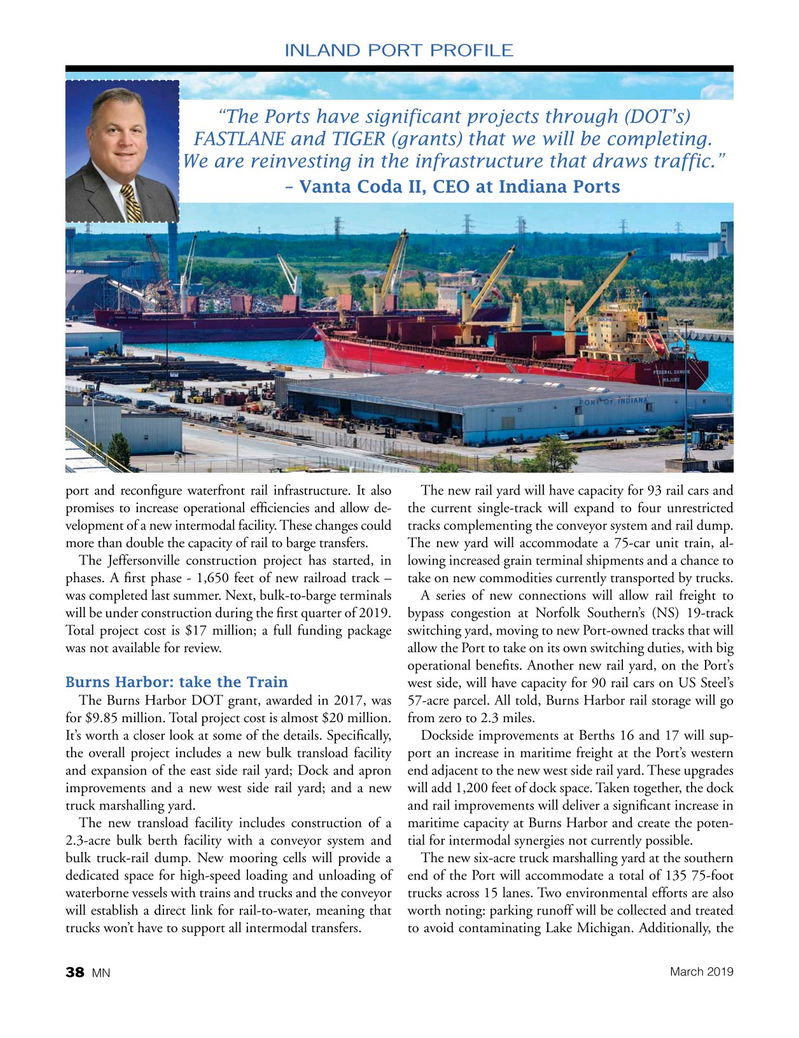
Page 38: of Marine News Magazine (March 2019)
Pushboats, Tugs & Assist Vessels
Read this page in Pdf, Flash or Html5 edition of March 2019 Marine News Magazine
INLAND PORT PROFILE “The Ports have significant projects through (DOT’s)
FASTLANE and TIGER (grants) that we will be completing.
We are reinvesting in the infrastructure that draws traffic.” – Vanta Coda II, CEO at Indiana Ports port and reconfgure waterfront rail infrastructure. It also The new rail yard will have capacity for 93 rail cars and promises to increase operational effciencies and allow de- the current single-track will expand to four unrestricted velopment of a new intermodal facility. These changes could tracks complementing the conveyor system and rail dump. more than double the capacity of rail to barge transfers. The new yard will accommodate a 75-car unit train, al-
The Jeffersonville construction project has started, in lowing increased grain terminal shipments and a chance to phases. A frst phase - 1,650 feet of new railroad track – take on new commodities currently transported by trucks.
was completed last summer. Next, bulk-to-barge terminals A series of new connections will allow rail freight to will be under construction during the frst quarter of 2019. bypass congestion at Norfolk Southern’s (NS) 19-track
Total project cost is $17 million; a full funding package switching yard, moving to new Port-owned tracks that will was not available for review. allow the Port to take on its own switching duties, with big operational benefts. Another new rail yard, on the Port’s
Burns Harbor: take the Train west side, will have capacity for 90 rail cars on US Steel’s
The Burns Harbor DOT grant, awarded in 2017, was 57-acre parcel. All told, Burns Harbor rail storage will go for $9.85 million. Total project cost is almost $20 million. from zero to 2.3 miles.
It’s worth a closer look at some of the details. Specifcally, Dockside improvements at Berths 16 and 17 will sup- the overall project includes a new bulk transload facility port an increase in maritime freight at the Port’s western and expansion of the east side rail yard; Dock and apron end adjacent to the new west side rail yard. These upgrades improvements and a new west side rail yard; and a new will add 1,200 feet of dock space. Taken together, the dock truck marshalling yard. and rail improvements will deliver a signifcant increase in
The new transload facility includes construction of a maritime capacity at Burns Harbor and create the poten- 2.3-acre bulk berth facility with a conveyor system and tial for intermodal synergies not currently possible.
bulk truck-rail dump. New mooring cells will provide a The new six-acre truck marshalling yard at the southern dedicated space for high-speed loading and unloading of end of the Port will accommodate a total of 135 75-foot waterborne vessels with trains and trucks and the conveyor trucks across 15 lanes. Two environmental efforts are also will establish a direct link for rail-to-water, meaning that worth noting: parking runoff will be collected and treated trucks won’t have to support all intermodal transfers. to avoid contaminating Lake Michigan. Additionally, the
March 2019 38 MN

 37
37

 39
39
